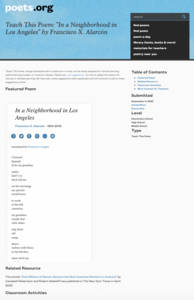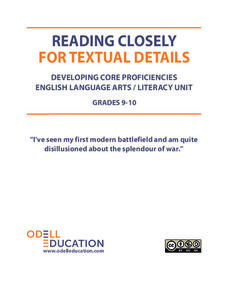K12 Reader
The Bug on the Rug
Where did that bug go? Kids can find out where it is by reading this short poem that features -ug words and responding to the three included reading comprehension questions.
New York State Education Department
Comprehensive English Examination: June 2012
Don't be so critical! During the final task of the Comprehensive English Exam, scholars choose two texts from their reading to discuss a perspective given from a critical lens. The exam also includes multiple choice reading comprehension...
EngageNY
Developing Reading Fluency: Selecting a Text and Practicing Reading Aloud
Young readers continue to strengthen their fluency skills with a text of their choosing. The teacher first engages the class with an audio recording or read-aloud of a short poem, modeling for children how to read fluently. Next it's...
Academy of American Poets
Teach This Poem: "In a Neighborhood in Los Angeles" by Francisco X. Alarcón
After sketching an essential person and reading an article, scholars read the poem "In a Neighborhood in Los Angeles" by Francisco X. Alarcón. They listen to the poem in English and Spanish and record lines that stand out to them. Small...
Read Works
A Bird Came Down the Walk
"A Bird Came Down the Walk" by Emily Dickinson is the focus text of a narrative poetry-based reading comprehension activity. After reading her poem, young readers respond to seven multiple choice and three short answer questions. The...
EngageNY
Reading about Freaky Frogs: “The Glass Frog”
Freaky frogs are the focus of a lesson plan designed to boost reading comprehension skills using text features and asking and answering questions. Informational text and a poem supply scholars with animal-related vocabulary and facts. A...
K5 Learning
Time for Everything
Read a historical fiction poem that explains how there is a time for everything in our daily lives. From sitting to sleeping, pupils read a rhythmic poem and respond to four comprehension questions.
Read Works
City Autumn
Glimpse a beautiful moment through poetry with a reading comprehension activity. As sixth graders read through "City Autumn" by Joseph Moncure March, they answer ten questions about the setting, mood, vocabulary, and punctuation of the...
K12 Reader
Feel the Green Grass
This poem may make your learners yearn for summer, but it will also help them practice the ee digraph. Pupils read the short poem, which includes many examples of the ee digraph, and respond to three reading comprehension questions.
Pleasantville Public School
Summer Reading Project
Summer means sun, fun, and a good book! Boost scholars' enthusiasm and proficiency in reading with a summer project of their choice—a book jacket, collage, or shoe box diorama. A variety of titles and authors from every genre offers...
K12 Reader
Kick the Brick
Your class won't say ICK when they see this learning exercise that focuses on -ick words! Learners read a short and silly poem containing many -ick words. They then practice reading comprehension and handwriting by tracing the answers to...
K12 Reader
The Pot is Hot
What do a pot and a robot have in common? They both end in -ot! Kids practice their -ot words by reading the short poem included here and then tap into reading comprehension skills by answering the three questions.
K12 Reader
Look at the Good Wood
Practice the oo digraph with a quick text and related questions. The short poem includes plenty of examples of the digraph. After reading, learners respond to the three reading comprehension questions.
Core Knowledge Foundation
Unit 1: Contemporary Fiction - They Call Me Güero: A Border Kid’s Poems by David Bowles
They Call Me Güero: A Border Kid's Poems by David Bowles is the focus of a five-week language arts unit unit. Fifth graders listen to various poems and participate in thoughtful discussions, examining vocabulary and learning new words in...
Annenberg Foundation
Poetry of Liberation
How do writers use words to protest injustice, challenge the status quo, and shape their own identities? Individuals watch and discuss a video, read author biographies, write poetry and journals, develop a slideshow, and complete a...
K5 Learning
The Wolf
Fourth graders have likely heard the expression to cry wolf, but they may not know the saying's origin. A short reading passage tells the story and includes four comprehension questions for pupils to demonstrate their understanding.
Read Write Think
Poetry Portfolios: Using Poetry to Teach Reading
Over the course of five periods, scholars create a poetry portfolio. They begin with a reading of the poem, Firefly. With a focus on vocabulary, learners reread the poem then look for sight words and other skills.
K12 Reader
The Snow Blows
Brrr! It's cold outside when it snows. Have your class read this poem about the snow to practice the long /o/ sound, -ow words, and reading comprehension. After reading, they respond to three questions.
K12 Reader
Two Hens in a Pen
Make a study of -en words with this exercise. Class members first read a short poem that incorporates many -en words. They then respond to three included reading comprehension questions about the passage.
EngageNY
Reading about Freaky Frogs: “The Water-Holding Frog"
Boost reading comprehension skills with a lesson all about freaky frogs. A poem hooks scholars and takes them into a reading of an informational text followed by peer discussions. A three-page worksheet focuses on text features and...
Academy of American Poets
Teach This Poem: "The Teller of Tales" by Gabriela Mistral
The poem "The Teller of Tales" by Gabriela Mistral is the subject of a thoughtful lesson that allows scholars to listen to or read the poem, then discuss its meaning.
Hong Kong Special Administrative Region
Learning English through Poems and Songs
Exposing learners to the power of words in poetry is a stimulating way to learn languages. Songs, haikus, rhyming words, and narrative works are all employed in a resource for teaching English as a Second Language.
Texas Education Agency (TEA)
Paradox (English III Reading)
Pairs of contradictory words introduce learners to paradoxes, the literary device writers use to get readers thinking deeply about their messages. An interactive lesson uses poems by Emily Dickinson and Wilfred Owen and excerpts from the...
Odell Education
Reading Closely for Textual Details: Grades 9-10
Pay close attention! After finding details in a picture, scholars begin to find details in videos and text. They work together in groups, discuss in pairs, and carry out independent reading to answer guiding questions. Organizers, tools,...

























